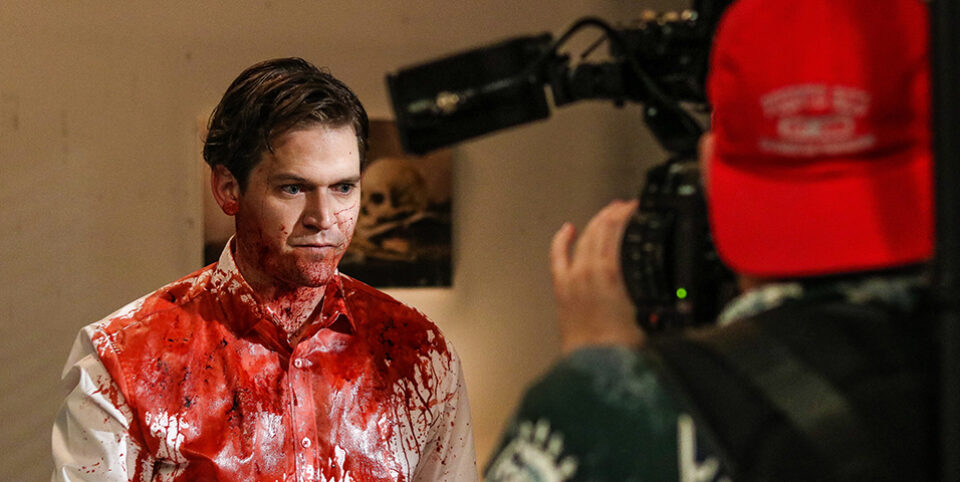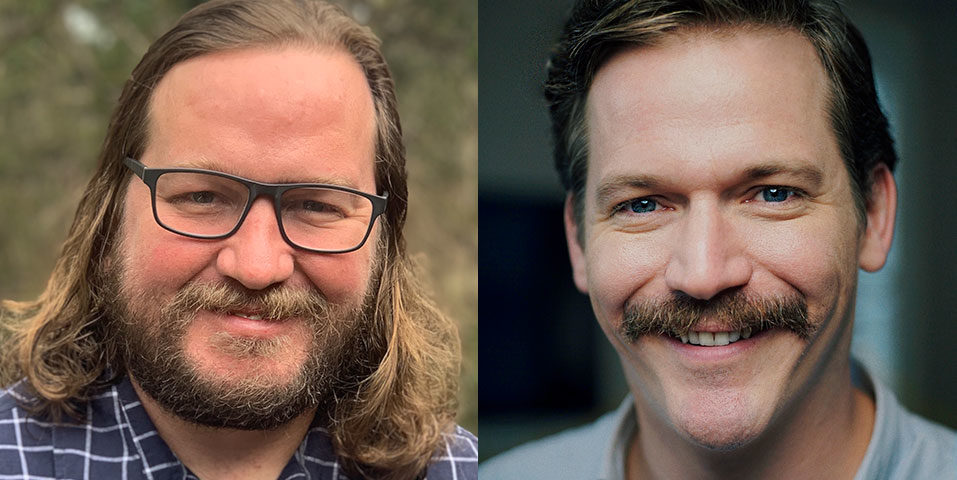Since its 2019 premiere, Brunch Shift Massacre, a short hospo-horror by director/writer/star Adam Boys (Bachelor of Arts Screen: Production, 2018) has become an audience favourite, touring back-to-back festivals worldwide and collecting dedicated fans along the way.
The darkly comedic tale of a waiter’s descent into madness during a busy brunch service is Adam Boys’ revenge fantasy love letter to every overworked, under-appreciated and underpaid hospitality worker, and was made as part of his final year studying the Bachelor of Arts Screen: Production at AFTRS. Boys worked with producer Tim Graham (BA, 2018), cinematographer Roger Stonehouse (BA, 2019), and production designer Oliver Levi Malouf (BA, 2018) on the short, which continues a successful festival run that’s seen the film win Best Student Film at 2019 MonsterFest and Best Ozploit! at the Sydney Underground Film Festival.
To coincide with the short’s premiere on AFTRS YouTube channel, Adam Boys sat down to discuss his work with current AFTRS Master of Arts Screen student, Adam Daniel. Turns out, these two have more in common than a first name. Daniel is a writer, director, and horror film aficionado, who has written a book on horror entitled ‘Affective Intensities and Evolving Horror Forms’. The Adams discuss influences, making Brunch Shift Massacre and the intersection between horror and comedy.
ADAM DANIEL: What was the inspiration of BSM?
ADAM BOYS: Actually, I’ve never thanked the person who inspired this movie. And the film has connected with so many people around the world, I really can’t wait for them to see it!
But long story short, I was working a brunch shift in a casual-fine dining restaurant in Vancouver, Canada, and this one customer was behaving peremptory with me up until they demanded to know where the bathroom was. And I had this epiphany in that moment that, despite their imperious façade, this customer was in fact about to perform an extremely human task and was extremely vulnerable while doing so, and would be susceptible to a hard kick in the skull against the tiles, and as I giggled to myself, I thought, I have to make that into a film. Thank you, Aggressive Customer!
AD: What drew you to working in the horror genre?
AB: I never thought I would make films in this genre, but was lucky enough to be cast to act in a slew of independent horrors and thrillers. I’ve watched horror films since I was 10 years old, I believe I started that journey with Children of the Corn (1984, dir. Fritz Kiersch). I’ve always loved horror, I just didn’t think I was mentally askew enough to make them. Only once I’d started making films in this genre did I realise that I was excising some societal angst of mine, and as a long-time fan of the genre, I had all the tools and knowledge to connect my angst with that audience. As it turns out I was deranged enough for horror after all.
AD: What do you think is the basis of the appeal of horror to contemporary audiences?
AB: I personally like the notion that stories are essentially cathartic. And I think the people who love horror, need catharsis in that area of their life; whatever the feelings are that horror films illicit, people are drawn to that rush and can go home satisfied with that release. Other people need to cry, or laugh, or feel feelings of love. Perhaps to add to an earlier point, fans of horror might connect with the social commentary of it all; zombies are never just zombies – they’re us!

AD: BSM is not only a gruesomely violent delight but also darkly comic. How do you see the intersection of comedy and horror?
AB: My Mum called me after watching the film with my Nanna, and through ashamed chuckles confessed that she felt bad for laughing as everyone was slaughtered. And I reassured her that that was the point. Spilling blood in a film is risky, it’s not always going to land. And comedy is the same. But if you look at many of the greats in the genre, they are often accented with comedy, like the work of Raimi, Kusama or Peele. In both genres, you’re playing with the audience’s expectations, and for me, it’s all about the audience, that’s the fun part.
AD: Sound and music are crucial to creating tension in horror. Can you discuss some of your choices regarding the sound design for BSM?
AB: You’re absolutely right, and we turn the dial to eleven once the massacre kicks in, but there was this one soundscape we lent into for the internal ramping of tension for The Waiter. There’s this silly referencing of the film Mercury Rising (1998, dir. Harold Becker) at the top and tail of the film. Well, the poster for MR is Bruce Willis holding the penis/vagina kid from Kindergarten Cop (1990, dir. Ivan Reitman) against this rush of lines. The shot is taken from this scene where Bruce Willis saves the kid from a speeding train, and the loud sounds of the train disturb the kid and it is absolute high stakes! So, as The Waiter’s patience is wearing thin and as he finally snaps, we underscore it with all kinds of train sounds, as another little nod to Mercury Rising.
AD: Why do you think horror is especially affective in short-form narratives?
AB: Back to the comedy angle, good short films are a set-up and a punchline. And a horror feature generally is a bunch of kills, with a series of set-ups, punch-someone-through-the-heart-lines.
In that way, shorts can be great because you only have to contend with one great set up and one great pay off. We just happened to make our set-up contain 15 or so people who all needed to die for it to pay off.
AD: What was the most difficult aspect of making BSM?
AB: I think, like most things we try to do in life, the most difficult thing is finding people who trust you and believe in what you’re doing. No-budget student films are, believe it or not, no exception. So, having a producer who backed my every move, who trusted the project and saw the potential was incredibly valuable to me. That way I could stay in the game when roadblocks appeared, or availabilities changed last minute. But I was lucky, because everyone else who was in, was in deep, and they all made this film what it is.
AD: What’s next?!
AB: Well, I’m was set to go back to BIFFF this year (before COVID-19 cancellations) with a new horror, We Met Online, which is a look at app-based dating and the horrors of treating people as disposable. It’s got some nods to Japanese folklore and horror. This one has way less humour, more supernatural horror and no dialogue – but still very much dealing with (my own) societal angst!
AD: In light of the cancellation of festivals and the large-scale societal shift to ‘online events’, what are the opportunities that this shift provides for filmmakers? Are there ways to capitalise on the new attention economy of the lockdown?
AB: The intention with BSM was always to get it online and in the hands of the people I was trying to represent – overworked and under-appreciated customer service people. Before the cancellations started coming, there were four festivals that we were set to play in this year, HorrorHound (H2F2), Fantaspoa, DROP and TISH. But as so many hospitality people were suddenly left without a job and forced to be stuck at home, AFTRS and I really wanted to get this film out there as something that might offer some solidarity and something to laugh at. I’m actually just so grateful that those film festivals supported this without question and got behind what we were trying to do at this unique time.
